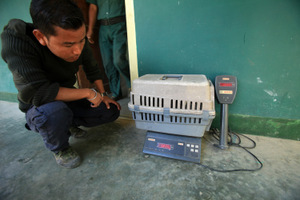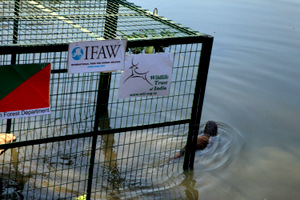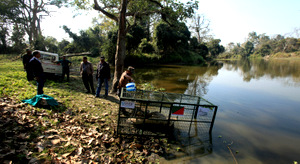First of its Kind Release of Rehabilitated Small Clawed Otter in Kaziranga
CWRC, Kaziranga, January 21, 2015: In a first of its kind, a Small Clawed otter (Aeonyx cinerea) that was hand-raised at International Fund for Animal Welfare (IFAW)-Wildlife Trust of India (WTI) run Centre for Wildlife Rehabilitation and Conservation (CWRC) in Assam was introduced to Baruntika Beel, a small water body near Kaziranga National Park.
While CWRC has rehabilitated several animals in the past, this is the first incident of hand raised otter being released back into the wild. The IFAW-WTI team comprising veterinarians, field biologists and animal keepers were at the site to ensure that the entire operation went on smoothly on Sunday, 18th January 2015.
“This is yet another achievement for the rescue centre. We have released several large mammals, but this one is special as it proves that we are dedicated to the welfare of all wild animals and not just the flagship species,” said Ian Robinson, Vice President, International Operations, IFAW-WTI.
This otter pup was rescued, with two others, in September 2013 by fishermen who found them floating on hyacinth leaves when floods had inundated the Kaziranga National Park. The fishermen took the three rescued otters to Dahgaon, one of the fringe villages in Kaziranga NP. Thereafter, sources informed forest officials and they rescued the otters on the same day. The Forest Department then handed over the pups to CWRC’s satellite unit, the Mobile Veterinary Service (MVS) team on the same day. Upon taking charge, the MVS team realised that the three pups were yet to open their eyes and needed care.
Over the course of the next few months, two of the three cubs succumbed and the only surviving cub, named Oliver by the CWRC team, was meticulously looked after so that he could be released into the wild. In order to achieve that, the CWRC team introduced Oliver to a makeshift water body where he was gradually allowed to fish and develop his natural instincts. Apart from this, he was milk fed and nursed.

IFAW-WTI team monitoring the otter before the release.
Photo:Subhamoy/IFAW-WTI
Soon, the instinctive behavioural changes were visible and Oliver was able to swim and catch fish too. “On October 25, 2014, Oliver underwent a surgery to implant a radio transmitter. This was conducted by the team of IFAW-WTI veterinarians led by Dr Bhupen Sarma of College of Veterinary Science, Assam. The otter recovered well after the surgery and resumed his normal routine. It was then decided that the time was right send the otter back to the wild,” said Dr Rathin Burman, Deputy Director, WTI.
Armed with the necessary permissions, the IFAW-WTI team decided to introduce the otter to a natural water body on January 18, 2015. The otter was introduced to a natural stream in presence of forest officials and the IFAW-WTI team led by Dr Rathin Barman. A team of IFAW-WTI field biologists will monitor the 16-month-old otter to ensure his well-being in this natural environment before he is released to the larger ecosystem.
“The team is monitoring the otter and I am happy to see it explore the wilderness of Kaziranga and get accustomed to a natural environment, three days after its arrival in this water body”, said, S K Seal Sarma, DFO, Kaziranga National Park.











